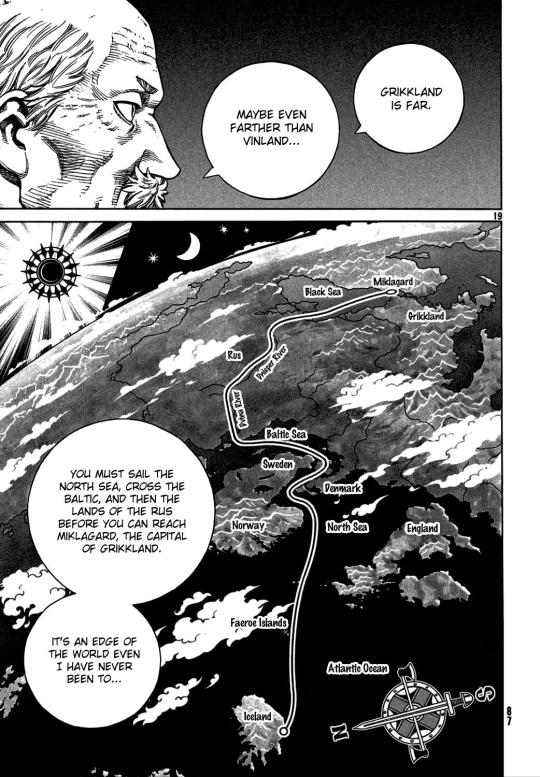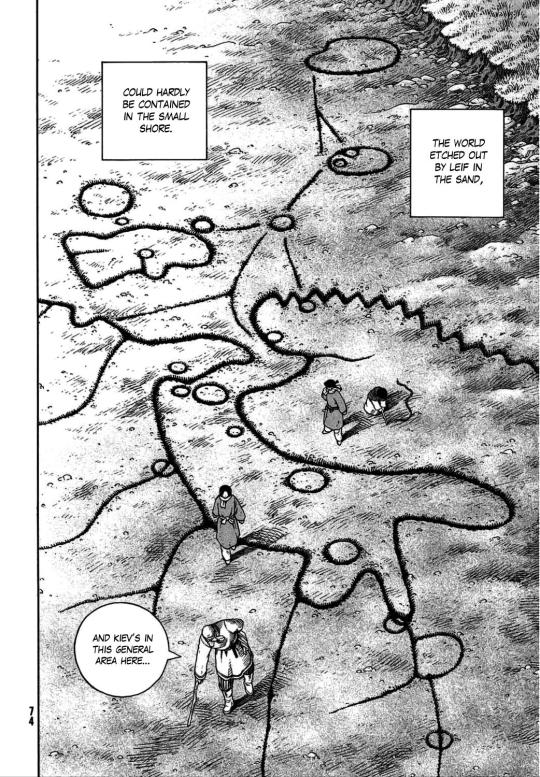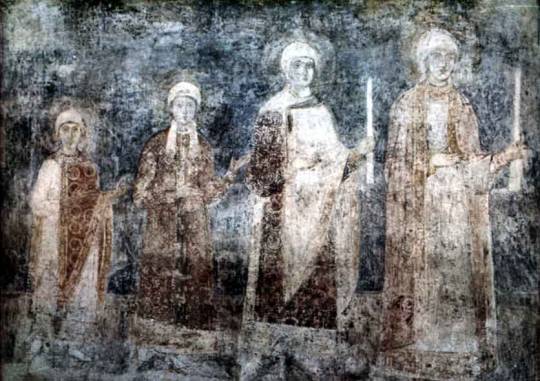#Norwegian and Icelandic have an interesting history as related languages but that’s not important to this discussion
Explore tagged Tumblr posts
Text
Offtopic: possible spoilers/teaser for future “Vinland Saga”manga chapters? Year 1019 in North/East European history

Basically, in the recent chapters of Vinland Saga the main characters have set up on a trip to Miklagarðr (Constantinople) to sell some narhval horns to the Greeks in order to raise money for their expedition to Vinland.

Well, it’s quite a detour of course and it’s, I dunno, probably somewhat a “cheesy” move, or how to put it, on author’s part,after arcs about war and thralldom, when main character finally is free and reaches his home, to make him go on a journey in opposite direction than that of Vinland where he’s to go to fulfill his dream, just to sell some stuff, but I actually liked this turn of events, and I believe it’s really justified to make the characters travel there.
Actually, it would almost be a crime not to make characters make travel there, as there was so much stuff going in those parts of the world in the time period covered by manga events, it really would be weird not to use it, and I hope you won’t find this post too long and boring to read it and see why is it so. Well, we can already see main characters having themselves caught in the middle of war in the Baltic Sea

However, as for what is going to happen on their journey next (of course if they will not find money in result of Baltic Sea war events and will continue their journey), I guess we can guess which historical events are the characters going to get involved into and what the characters are going to encounter, since we’ve seen quite a few hints already. For example, to reach Miklagarðr from Iceland they could theoretically take two routes: one is to go south and then go through Gibraltar (somewhat like Bjǫrn Járnsíða did) and after that going past Italy to reach Miklagarðr from the West. Though obviously the characters went East right away and went to the Baltic Sea, which indicates that they will likely be taking (of course if they will still be going to Constantinople) the historical trade rout “from the Varangians to the Greeks” which did actually connect Scandinavia with (Eastern) Roman Empire. Actually, as you can see on the manga page below the route the characters were planning to take has already been shown, and it has “from the Varangians to the Greeks” route as its part, where they would go from Baltic Sea along the Dnieper river (though, theoretically the still can take Dniester) South across Garðaríki to the Black Sea and from there to Grikkland.

And it’s actually quite interesting, since taking such route they will most likely visit Kænugarðr (or Kijev) along their way. The city was an important point on the trading route and (not surprisingly) an important center (if not capital, though hardly such term is 100% applicable) of Kievan Rus' (or Garðaríki) which was an East Slavic state although ruled by the rulers of the Rurik dynasty which was of Norse origin (named after its founder, who’s mentioned in Slavic sources as Rurik, but, of course if you’ve even simply watched my Dark Souls etymology videos I guess it would be quite obvious that the origin of the name is Germanic, composed of elements *hrōþiz - for loud, or rather famed, in this case, and *rīks - king, ruler, an element we’ve seen in quite a few Dark Souls names).

And it happens so that the years of the manga events (1019 in the recent chapters, possibly 1020 by the time characters would reach Kænugarðr, provided they ever will, of course) match the first years of the reign of a person known to Norse peoples as konung Jarizleifr (also I believe he was called “the Lame” for indeed it seems he used to limp) as high ruler of Kijev (the stuff I read about when working on an old Cossack cosplay video, which wasn’t even related to the cosplay in the end =/). Bascially about 50% of the name “Jarizleifr“ has no real meaning in Old Norse, since it’s just an adaptation of a Slavic name Yaroslav (from Proto-Slavic *jarъ- “furious/fierce” and *slava - “fame/glory”), with “lav” part of “slav” element broken separately and taken as “leif” or “leifr” which is Old Norse for “inhertior/heir” and of course can be seen in the name of Leifr Eiríksson who is both a historical character and one of the major characters in the manga. But, anyway, returning to the historical events which will possibly be covered in manga - the ruler of Kænugarðr in the years the manga events cover was prince Yaroslav the Wise, who himself was a descendant of Rurik and whose wife (whom he married in... 1019) was Princess Ingegerd of Sweden, daughter of king Olaf of Sweden.


And Yaroslav’s way to power as ruler of Kijev was marked by a struggle for power against his brother Sviatopolk and foreign invasions (like of Poles under Bolesław I Chrobry (the Brave) who supported Yaroslav’s rival Sviatopolk) in 1018, with Yaroslav finally winning the throne against his brother in... 1019. Although Yaroslav’s victory was only followed by a conflict against own nephew Bryachislav, whom he fought and defeated in 1020. And these historical events are actually covered in Norse sagas (well, more correctly in þættir - sort of “short sagas”) namely the story of Eymundr, which tells of a Norse konung Eymundr who, not willing to fight against king St. Olaf II Haraldsson of Norway (as Olaf began joining Norðvegr under his own rule) and hearing the news of power struggle among brother-princes in Garðaríki following the death of konung Valdemarr (prince Vladimir), leaves his homeland together with his friend jarl Ragnarr and their men (whom include not only Norwegians but also Icelanders) to offer their services as mercenaries to Jarizleifr or whoever will treat them better. Well, since it’s a Norse story, it’s somewhat hard to say how much does it exaggerate things when it tells about greedy local ruler who can’t handle anything by himself without his wise Norse wife and is several times saved by mercenary Norsemen who aid him in war against his relatives and give him wise counsel, whom he however tries to trick in times of peace when he thinks he doesn’t need them already. And eventually (although after defeating one of the “three brothers” - Burizleifr, whose name is likely derived from the name of the Polish Duke Bolesław who supported and gave army to the actual brother Sviatopolk) Eymundr and Ragnrarr leave Jarizleif to serve “third brother” Vartilafr (likely rather nephew Bryachislav whose name likely has the very same origin as such names as Wrocisław or Vratislav in other Slavic languages) and when the two armies confront each other Eymundr manages to negotiate peace between “brothers” with Ingegerd, Jarizleif’s wife. And subsequently Eymundr got lands for himself becoming a “guardian” of the local state and it’s also said that together with Ingegerd they used to solve all the serious problems in Garðaríki . So, returning to manga, Garðaríki wouldn’t really be that much of a foreign place to the heroes of Vinland Saga (well foreign, but with lots of their kinsmen involved, and I believe the inhabitants of Kijev were called “Danes” in some Western European sources at that age, apparently because the ruling dynasty there was of Norse origin), and there was really lot of interesting stuff going on historically (and described in þættir) involving Norsemen (and particularly Icelanders) in the very same years the manga covers, and that only in that one spot of the route which the heroes, it seems, are going to take. And I guess it would be strange if it’s not going to be covered in the manga. So, escaping the power struggle for throne of Denmark and power struggle within the Jomsvikings, the characters might arrive to Garðaríki to get involved in power struggle there, and who knows, maybe it will be the pacifist Þorfinnr Karlsefni of the manga who will negotiate peace between rival parties of Garðaríki conflict in 1019/1020 ? Another dimension is that Garðaríki had already adopted Christianity, but from Byzantine Empire, and although Leifr is Christian also, he’s rather a Western Christian, while the events of manga take place just some decades before the East–West Schism (which only finalized the process that had been going on for some time already), so it’s interesting if it’s going to be covered as well. But anyway, it’s only one point of the possible route, and after Kænugarðr there are Dnieper thresholds to the south with Turkic nomadic peoples ambushing the traders and so on and so forth, all the way to Miklagarðr where Roman emperors had Varangian guard and, for example, one could find some Norse Runic writings on marble parapets mentioning some Norseman Halfdan....

So the historical period is quite exciting offering lots of opportunities to make some very interesting stories, even before finally “sending” the main characters to Vinland and I’m really looking forward to see if my guesses were right or not
#Vinland Saga#Vinland#Thorfinn#Leif#Garðaríki#Gardariki#Miklagarðr#Miklagard#Constantinople#Roman Empire#Vikings#Jarizleifr#Kiev#Kyiv#Kaenugard#Lore#Yaroslav the Wise#Eymund#Ragnarr#Ragnar#Saga
49 notes
·
View notes
Text
Speaking as someone who grew up in a homeschooling family, I'm very grateful that I did.
Speaking as someone who grew up in a homeschooling family, I'm very grateful that I did.
Someone referred me to this subreddit a few days ago, and I've been lurking here since. It's been very interesting reading all of the experiences on here, albeit many of them are more from the vantage point of the parent rather than the student. It is still very obvious that many of you are deeply invested in your children's futures, and that's something that makes me very happy. My siblings and I were all homeschooled, all eight of us actually.
We grew up in an area with a lot of other homeschoolers as well, and overall there was a strong current of self sufficiency, heritage, and simplicity that ran through our entire community. We didn't grow up with a TV or internet or a lot of modern accessories, but I think that even if we did, they would have likely remained untouched anyway, there was always a lot of ways we could entertain ourselves or pursue our interests.
Now that we're grown up, our parents are now grandparents, and we all have our own families to take care of. Homeschooling is a big part of who I am today in terms of knowledge, skills, and character. I want to extend the same sort of gift to all of my children as well, and so far, I have. My parents were motivated to homeschool us because they were disillusioned with the educational system back then and mainstream society in general.
It wasn't really particular religious, but we were raised to value our heritage, have self awareness, have self control, and behave morally. The overall method they used I'd say was largely a hybrid between classical education and unschooling. It wasn't very rigid at all, each of us advanced at our own pace. You could describe it as focusing on building a strong foundation for each child when they're young, but then after that, let them immerse themselves in what they're passionate about.
We each were taught the 6 Rs, in no particular order, each are considered vital, like an organ of the body:
Reading: Pretty self explanatory, we were each taught how to read, starting at 3-4 years of age and building up on that. Fortunately each of us quickly gained a strong passion for reading. We all were ahead of our grade level quite quickly.
wRiting: This doesn't need much explanation either. We each had to learn how to write. A lot of it was penmanship, spelling, grammar, etc. It didn't have to be perfect, but the goal was to be competent. A lot of it was intertwined with reading.
aRithmetic: You have to know how to add, subtract, multiply, and divide, don't you? This also extended to other basic concepts in math that are useful in everyday life. Personally, I love math, and I quickly got pushed ahead to more complex topics such as Algebra, Calculus, Game theory etc.
Roots: Our family, particularly on mother's side, has a very extensive and vivid oral and material history. My maternal ancestors have kept tons of documents, photographs, artwork, journals, etc. over the centuries. My parents considered passing on our family's heritage to be very important.
Rhetoric: My dad loved to teach us this topic, The Art of Discourse. Logical fallacies, critical thinking, persuasion, and cognitive biases were among the many things we were taught to recognize and use from as early an age as possible. Socratic dialogues were a big part of this, I loved this topic just like my father does.
masteRy: This, "R" would be the most nebulous. Think of it as the self awareness and self control I mentioned earlier. We were taught to cultivate compassion, restraint, industriousness, and humility. My parents didn't have a lot of rules, rather they focused on helping us build up our moral compass so we wouldn't need rules to act ethically.
Despite how it might sound, the way we were taught was far from rigorous or demanding. We each advanced in each of the "Rs" at our own pace, as long as we were making a genuine effort to advance. This worked out very well, mom had an amazing talent for motivating children to want to succeed. It wasn't one of the 6 Rs, but we all naturally were multilingual children just by sheer exposure. In our household, Swedish, Icelandic, Norwegian, German, and Danish were thrown around as easily as English as a part of honoring our Northwestern European heritage.
After we became competent in each of those areas, we could fully immerse ourselves in whatever interested us. My parents kept tons of books in our house on a wide variety of topics to choose from. I'm talking a lot of books, ranging from things like linguistics, literature, biographies, mathematics, history, sociology, philosophy, physics, astronomy, geology, chemistry, medicine, psychology, neurology, engineering, you name it there was likely a book that was at least tangentially related to it. Both of my parents were avid readers who loved to collect all sorts of tomes, the majority of them weren't even in English.
I mentioned this a bit before, but I loved mathematics as a child. So by the time I was beginning to hit puberty I was delving into things like dynamical systems, topology, game theory, statistics, and harmonic analysis. I probably wouldn't have had the opportunity to advance at the pace I wanted to if I was in public school. However, I also really liked studying linguistics, biology, history, spirituality, and philosophy. Although really, I liked to read anything I could get my hands on. My siblings had their own interests as well and they got to dive as deeply as they wanted to as well.
One passion I clearly got from my father was his love of ancient languages and literature. He was absolutely enthralled by ancient languages and their poetry, especially Indian epics like the Mahabharata. I quickly gained an interest in Sanskrit among other things quite early as well. Later on, I'd begin to study Avestan, Pali, Aramaic, Biblical Hebrew, Latin, Old Norse, etc. later on. I would continue to dabble in tons of languages over the course of my life. I'd consider it one of my hobbies that I try to spend some time everyday on.
The languages I mentioned earlier are the ones I'd be roughly on the level of a native speaker in, mainly because I began picking them up at a really young age. Fast forward 25 years later, and I'm pretty good when it comes to Romance languages, not quite as fluent as a native, but I can keep up very well. My Balto-Slavic languages are also pretty good if the conversation isn't too intense. My Semitic languages could be a lot better, it helped that I had a good foundation in Biblical Hebrew and Aramaic, but in terms of speaking them naturally, I'm only so-so.
I think that this entire homeschooling experience is what really helped me to become successful later in life, moreso than if I was educated in the public school system. I could talk about this kind of thing all day, I mainly just wanted to share my experiences. I hope that it strikes a chord with some of you, or, if you're new to the topic of homeschooling, perhaps it will even inspire you. I'd be happy to answer any questions that you have as well. Keep up the good work you guys.
0 notes